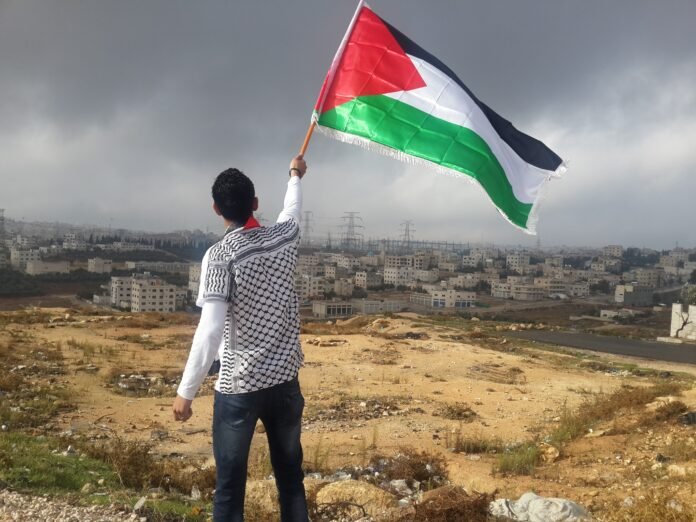Residents of Gaza have been subjected to a severe blockade for the past sixteen years, which allows Israel to control the flow of electricity, petroleum, food, water, and medical supplies. So that they can determine when Palestinians receive basic necessities and when they are denied. This power derives from violence and devastation.
Gaza was a part of what became known as historic Palestine prior to the establishment of Israel, which the Ottomans ruled over before the British occupied it. As the British prepared to abandon Palestine in 1947, they left its fate to the newly formed United Nations, which voted to partition Palestine into a Jewish state and an Arab nation. In order to establish the state of Israel, Zionist forces and militias soon began forcibly expelling hundreds of thousands of Palestinians from their land. A large number of internally displaced Palestinians retreated to this narrow strip of land, which was later dubbed the Gaza Strip. Therefore, these individuals became refugees because they were expelled from their cities and communities. Some of them reside a literal mile away from their former towns and villages. Others were compelled to escape to nearby Arab countries. These countries, overwhelmed by refugees, promptly declared war on the new state of Israel in support of Palestinian Arabs.
They ultimately lost to Israel, but Jordan occupied the West Bank and Egypt occupied Gaza City and surrounding villages along these cease-fire lines. Then, in 1967, another conflict erupted. Israel launched a full-scale assault against Jordan, Syria, and Egypt in response to Palestinian resistance and Arab-adjacent country threats.
Israel captured the Gaza Strip and Sinai from Egypt, the West Bank from Jordan, and the Golan Heights from Syria in just six days. This marked the beginning of Israel’s occupation of Gaza, which persists to this day. Israel seized control of all land, air, and sea traffic from and to the Gaza Strip.
It also permitted Palestinians to travel between the Gaza Strip, Israel, the West Bank, and East Jerusalem. In official Israeli documents, Palestinians began to be referred to as “foreign residents” or “non-citizens” just a few months after the conflict, despite the fact that they were now under Israeli control.
The status is inherited from your parents and ancestors. You are aware that being stateless, unrecognized, and without rights impacts your existence. This is also when Israel began constructing Jewish Israeli settlements in Gaza. For Palestinians, this meant the confiscation of even more land.
They were also being confined. Israel prohibited Palestinians from operating their own airport or seaport. Israel developed critical industries in the Gaza Strip, such as agriculture, to serve Israeli and West Bank markets, taking advantage of Gaza’s inexpensive labor market and paying Palestinians very little.
These economic difficulties led to the development of Mujama al-Islamiya, a prominent Islamic social charity. For Palestinians in Gaza, this charity built schools, mosques, and clinics and gave them extra food at the time with some assistance from Israel. But tensions persisted. Israel dreaded the expansion of the resistance movement.
In response, soldiers frequently frisked, arrested, and detained locals. In 1987, this tension reached its breaking point when an Israeli lorry collided with a civilian vehicle, resulting in the deaths of four Palestinians. Palestinians immediately responded to occupation with demonstrations, strikes, and boycotts. It became known as the first rebellion or uprising. In the same year, Mujama al-Islamiya transformed into the terrorist organization Hamas. Hamas was established during the initial Palestinian insurrection. And had been absent from institution politics for some time. They were not yet in control of Gaza, but they desired to free Palestinian territories from Israeli rule.
Israel was considered an illegitimate entity. After the first year of the intifada, during which over 140 Palestinians were slain in Gaza, Hamas and other militant groups launched more direct attacks against Israelis. The violence of the intifada escalated in 1991, the same year that Israel introduced a permit system that severely restricted the ability of Gazans to work.
Passage through Israel is required to reach the West Bank and East Jerusalem. By the conclusion of the First Intifada, Israeli forces had killed more than one thousand Palestinians, and Palestinian militants had killed more than one hundred Israelis in Israel and the occupied territories. The uprising concluded with the conclusion of the Oslo Peace Accords between Israel and the Palestine Liberation Organization, or PLO. This was an armed liberation movement that fought for decades for Palestinian rights. The PLO consented to disarm and acknowledge Israel’s existence. However, Hamas, which at the time had very little political support, vehemently opposed it.
The agreement also established the Palestinian Authority, or PA, which permitted political parties and elections in the Gaza Strip. The PA was granted autonomy over a few minor areas, but Israel continued to control the territories and the flow of traffic through these checkpoints. In addition, the Oslo Accord guaranteed Palestinians autonomy as well as a path to statehood within five years. However, this never occurred. Instead, more Israeli settlements were established on Palestinian land. A year later, in response to an attack by an Israeli settler in the West Bank and a succession of bombings by Palestinian militants, including Hamas, the Israeli prime minister called for the construction of a fence around the Gaza Strip.
Gaza was now physically separated from the rest of the globe. These actions eroded the Palestinians’ faith in the Israeli government and peace negotiations, leading to a second uprising. On September 28, 2000, Israeli politician Ariel Sharon visited Al-Aqsa mosque, a muslim holy site in Jerusalem that is mainly inaccessible to Palestinians in Gaza.
This visit prompted widespread protests and violent clashes, leading to the murder of four Palestinian children by Israeli forces the following day. In addition, Palestinian militants conducted suicide explosions. Back in the Gaza Strip, Palestinians destroyed a significant portion of this barrier. The Israeli government quickly rebuilt it and fortified it with additional forces and observation posts.
In addition, they canceled travel and work permits, further restricting movement through this crossing, and ultimately devastated Gaza’s only major airport and its port-in-construction. Palestinian militants killed over 900 Israelis by the conclusion of the Second Intifada in 2005, while Israeli forces killed over 3000 Palestinians.
Israel progressively ended the Second Intifada by dismantling all Jewish Israeli settlements in the Gaza Strip and withdrawing its ground forces. The PA was then given sovereignty of this crossing with Egypt on the Gaza side, allowing trucks and convoys to travel between the Gaza Strip and the West Bank, as a result of another international agreement.
But Israel prevented this from occurring. The PA and PLO-supported Fatah party, which had negotiated with Israel, was in power at the time of the first legislative election after the Second Intifada. However, numerous Palestinians viewed Fatah and its strategy as ineffective. Hamas, which was now a political party as well as a militant organization In 2006, a majority of the seats were gained. People voted for Hamas in order to express their disapproval of the current status quo, which consisted of a failed peace process, two uprisings, and no state in sight. In response to the victory of an armed militant party, Israel prohibited workers from leaving Gaza for employment.
Then, when militants kidnapped an Israeli soldier, Israel launched airstrikes in Gaza and restricted fishing to a six-mile radius. Hamas had won the election in Gaza on a political level, but the PA was still the governing body, with Fatah under its aegis.
A conflict erupted between Hamas and Fatah, and in 2007, Hamas assumed control of the entire Gaza Strip. This is when Israel imposed the official blockade that continues to this day, further tightening its hold on Gaza and trapping over 2 million Palestinians within. This time, Israel shut down the principal commercial crossing, increased restrictions on travel, prohibited exports from Gaza, and imposed import restrictions on essential items such as fuel, medication, and food. Even mathematical formulas were used to determine the required caloric intake of Gazans in order to control the amount of food allowed in.
In essence, we die a lingering death in Gaza. Even before significant escalations. People are unable to travel freely. We have Israeli drones circling the area around the clock. There is perpetual tension. In the years that followed, recurring conflicts and bombardments exacerbated the already devastating effects of this blockade. Israeli airstrikes destroyed water and power facilities. Due to the obstruction, repairs were delayed, and the delivery of construction materials was impeded. And for every attack by militants on Israelis, Israel retaliated by killing many more Palestinians. Occasionally, Israel would loosen restrictions marginally, but it never came close to meeting the humanitarian needs of Palestinians in Gaza.
According to a 2022 UN report, the 16-year blockade had rendered 78% of the water in Gaza undrinkable, left 62% of Palestinians in Gaza in need of food assistance, and caused rolling electricity outages that lasted an average of 11 hours per day. This is our daily routine. We would have eight hours of power, twelve hours of power It varies based on the circumstances and the availability of petroleum. We are totally reliant on Israel. Many Palestinians and international law refer to this as collective punishment. Collective punishment is when cancer patients are unable to travel due to being denied. And collective discipline It also implies that Palestinians cannot operate their own hospitals or treat their patients. For the most recent escalation, the people of Gaza are now punished with collective punishment. When considering the crime of genocide, which is the deliberate annihilation, in part or in whole, of an entire people, elements of this offense are currently being committed and carried out in the Gaza Strip. There is a correlation between Hamas and all Palestinians. And this will not be the first time that civilians in Gaza, half of whom are minors, will pay the price for Hamas or any other cause.
Israeli and American leaders have emphasized that Israel has the right to defend itself by eradicating Hamas. However, the preponderance of Gaza Strip casualties are not Hamas fighters. They are citizens. If Hamas did not exist, would things have been different?
However, Hamas did not exist until the late 1980s. Since 1967, however, the Palestinian territories have been occupied. And the first Palestinian exodus occurred in 1948. Furthermore, Hamas did not emerge until much later. Anyone who observes Israeli and Palestinian politics with a modicum of integrity because the status quo was unsustainable, everyone knew that if what occurred hadn’t occurred, something else would. The world must acknowledge this suffering. Even before escalations occur, the reason there are escalations is because people lack hope. Nobody wanted to reach this stage.
The tragedy of the situation, in my opinion, lies in the fact that it was readily preventable and could have been avoided.



